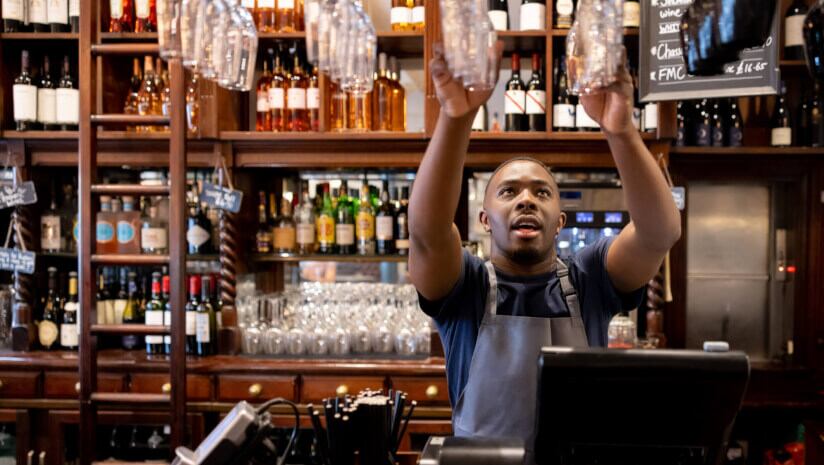Panel host Laura Willoughby, who founded responsible drinking movement Club Soda, talked with three guests at a conference held by KAM last month at Angel, north London, on the insights firm’s 2024 Low and No: Drinking Differently report, which was produced with Lucky Saint.
Willoughby asked panellist Kelly Moss, who is Wine & Spirits Trade Association (WSTA) head of compliance, about the definitions of no, low and light alcohol.
Moss said: “It is really complicated. It’s something I’ve been trying to get on top of for as long as I’ve been at the WSTA, which is seven years.
“Low & no are separate products but for data purposes, specifically, people tend to group them together.

“There’s not even a legal definition for alcohol-free, it is simply guidance stating it has to be 0.05% and below.
“The real barrier to these products is accurately describing them, which is why we had to produce some labelling guidance for our members and admittedly it’s only on spirits at the moment, wine is even more complicated, especially with DEFRA playing with the legislation and the potential change to the definition of wine at the moment.
“Maybe another barrier is because while at the basic level no, low and lower provide the same function in providing options for people who want an alternative choice to an alcoholic beverage, each category is separate and attracts different consumers.”
A drink that tastes nice
Moss continued: “We always talk about ‘low’ and ‘no’ but ‘lower’ has such a crucial role to play in trying to get people to reduce their alcohol consumption. ‘Low’ is 1.2% and ‘lower’ is 30% reduced compared to a full strength. They have completely different rules. No and low is guidance while lower is legislation-based.”
Lo No Drinker magazine editor Denise Hamilton-Mace, who was also part of the panel, said: “They just want to have a drink that tastes nice. Ultimately, the terminologies that we use and whether you call it a lower or mid-range that a lot of people refer to is really something that we, in the industry, use for our own needs so that we know how to label things and we know where to put them on shelves and how to measure our sales.

“Consumers want stuff that tastes good and at the end of the day, I don’t think that most people really care too much what names you want to put on something as long as they understand what it is that they’re getting.
“The bigger challenge is making it so that when somebody goes into a supermarket or into a bar or a restaurant, when they can look on the menu and they can see what their options are and understand what they can choose, then they will be happy.
“The biggest thing I hear from people is they don’t feel they have good-quality adult choices when they are out.”
Willoughby pondered whether consumers actually understand what ABV is.
Hamilton-Mace replied: “No, I don’t think that most people understand ABV as a term. And I certainly don’t think the consumers understand ABV when it comes to a mixed drink. I worked in hospitality for 24 years myself and I still couldn’t tell you the ABV of a cocktail once it’s made.
“One way that a few people have suggested to me that they think might make things easier would be to actually look at the units of a drink rather than the ABV.”
Stigma attached?
Panellist Dan Crowther, managing director of Hedonist Drinks, said: “We count our calories. We count our steps. The next thing is counting our alcohol intake in units and that’s the easiest way currently in in the UK and in other markets.”
Perhaps there is a stigma attached in the consumption of lower alcohol products, Willoughby asked.
Hamilton-Mace answered: “There is sometimes a stigma to mid-range drinks because you have a group of people who are firmly on the alcohol-free side and then you have a group of people who are firmly on the let’s go out and get pissed side – and not many people understand that middle lane.
“But a lot of people are telling me they want to find a middle ground where they can sit comfortably in for those midweek moments that will remove that stigma.”
Even the mid strength area is another bone of contention, particularly in wine suggested Willougby. She said: “Mid strength is another area that wine needs to push into because people see it as a high strength product that, particularly if you’re serving yourself at home, might come in quite large measures.”
Crowther said that on Hedonist Drinks menus, different coloured cocktail shaker images are placed next to each drink to show the associated ABV strengths of those drinks.
Willougby asked: “Do you think venues don’t like putting ABVs on their menus because it would stop people buying so much?”
Hamilton-Mace cited the figure stated in the report that £800m is being missed out on by the on-trade by people asking for tap water rather than a paid-for alternative and said: “Any venue that could find a way to improve those sales by offering their guests what they already want would be very misguided to not jump on that opportunity.”




